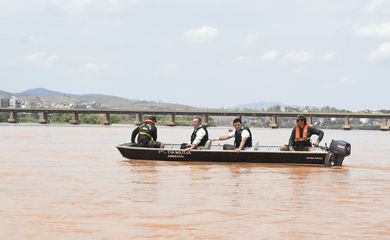Doce River water unfit for use two years after Mariana tragedy


An expedition carried out from October 11 to 20 surveyed the trace of mud over the course of the Doce river from its formation—the point where rivers Gualaxo do Norte(photo), Piranga, and Carmo meet—up to a hundred of tributaries that form the basin and feed 29 municipalities and districts in Minas Gerais and Espírito Santo.

The water in the Doce River basin is not fit for drinking, fishing, irrigation, or food production by any of the criteria considered by the SOS Mata Atlântica Foundation. The study was conducted across 733 km where the mud devastated the local landscape in Brazil's biggest environmental tragedy, over two years ago in the town of Mariana, Minas Gerais, in the Southeast of Brazil.
The Doce River basin was contaminated after the collapse of the Fundão dam, belonging to mining giant Samarco, on November 5, 2015. The incident destroyed the native vegetation and polluted all of the basin, affecting other municipalities in Minas Gerais and the neighboring Espírito Santo state. Nineteen people were killed and a number of communities were hit.

The water shows high concentration of solid solid matter in suspension and heavy metals, like manganese, copper, aluminum, and iron, several of the sections surveyed.
According to the research, the quality of the water in the basin is poor or terrible in 88.9% of the collection spots and OK in 11.1%. Nowhere was the water found to be good or great in quality.
An expedition carried out by the foundation from October 11 to 20 surveyed the trace of mud over the course of the river from its formation—the point where rivers Gualaxo do Norte, Piranga, and Carmo meet—up to a hundred of tributaries that form the basin and feed 29 municipalities and districts in Minas Gerais and Espírito Santo.
Deterioration
In 2017, the quality of water is reported to have deteriorated compared to the 2016. Last year, the water was considered poor or terrible in 53% of the collection spots, OK in 41%, and great in 5.9%. The figures this year are close to those observed right after the tragedy, in November 2015.
The survey also detected the absence of aquatic animals—like tadpoles, toads, and fish—in seven of the 16 spots where water quality is terrible or poor.
“In these places, the surface was infested with insects and mosquitoes, vectors of serious diseases like dengue, Zika, chikungunya, and yellow fever,” said Malu Ribeiro, a water expert at SOS Mata Atlântica, in charge of the expedition.
According to Ribeiro, sedimentary ore deposits can be found all throughout the river bed, even though the water looks lighter. “The extreme drought and the low volume of water resulted in the concentration of pollutants, which has made the pollution less visible to the naked eye,” she explains.
The water shows high concentration of solid solid matter in suspension and heavy metals, like manganese, copper, aluminum, and iron, several of the sections surveyed. Only two collection spots, located in Perpétuo Socorro and Governador Valadares—both on the Doce River—did not show any rate of copper in the water.

In 2017, the quality of water is reported to have deteriorated compared to the 2016. The figures this year are close to those observed right after the tragedy, in November 2015.
Signs of life
Nine collection points were observed to present signs of water life, despite the far-from-ideal conditions. They are located at the same spots where fragments of the native forest can still be found or in areas of permanent preservation.
In order to bring water quality levels up again, Malu Ribeiro argued, native species must be returned to a restored forest, and basic sanitation and environmental services expanded in the affected area.
Translated by Fabrício Ferreira
Fonte: Doce River water unfit for use two years after Mariana tragedy


